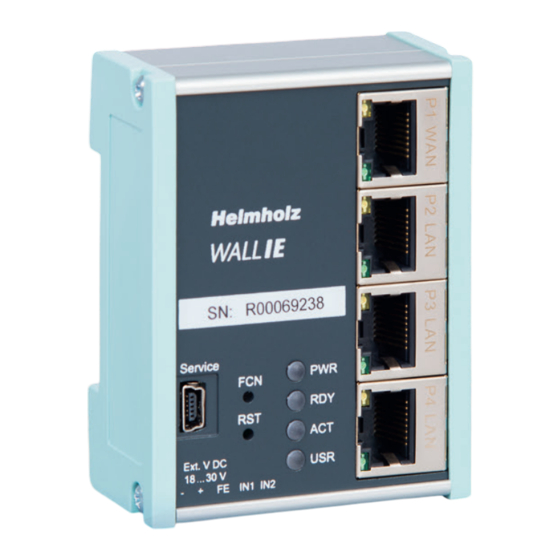
Helmholz WALL IE Quick Start Manual
Hide thumbs
Also See for WALL IE:
- Manual (63 pages) ,
- Quick start manual (24 pages) ,
- Quick start manual (23 pages)
Summary of Contents for Helmholz WALL IE
- Page 1 Quick Start Guide WALL IE Version ab FW 1.00 www.helmholz.com www.helmholz.com...
-
Page 2: Table Of Contents
5. The bridge mode 6. Packet filter functionality 7. NAT operating mode 8. Basic NAT 9. NAPT 10. Port forwarding 11. Static routes 12. Resetting to factory settings 13. LED status information 14. Technical data Quick Start Guide WALL IE... -
Page 3: Introduction
Please note: Please observe the safety instructions for the product, which can be found in the manual. It can be downloaded from the website www.helmholz.com in the download area. This document should explain the initial commissioning of the WALL IE on the basis of simple examples from network technology. P1: WAN Port FCN: Function Button P2—P4: LAN Ports... -
Page 4: Initial Access To The Web Interface
3. Initial access to the web interface The WALL IE is set on the LAN-side at the factory with the IP address 192.168.0.100 and the subnet mask 255.255.255.0. Access to the web interface is only possible via the LAN connections P2- P4. -
Page 5: Adjustment Of The Ip Addresses
You will be prompted to set a password with the initial registration. With the „Con- tinue“ button, the password is stored in the device and you will be forwarded to the „Overview“ page of the WALL IE. The main user is always „admin“. Another user administration hasn‘t been imple- mented yet. -
Page 6: The Bridge Mode
5. The bridge mode In the bridge operating mode, WALL IE behaves like a layer 2 switch between the automation cell (LAN) and the production network (WAN). The packet fi lter can be used to limit access between the two areas. -
Page 7: Packet Filter Functionality
Switch the WALL IE to the bridge mode via „Device Operating Mode Bridge“. In the bridge mode, the IP address of the WAN interface is the same as the IP address of the LAN interface. It is thus transparent. - Page 8 „Drop“ rejects a packet muted and „Reject“ responds with an ICMP error message. Comment A comment can be entered here. Status Rule active (A click on the lamp changes the status.) Rule inactive (A click on the lamp changes the status.) Deletes a rule Adds a rule Quick Start Guide WALL IE...
-
Page 9: Nat Operating Mode
In the NAT operating mode, WALL IE forwards the data transfer between various IPv4 networks (Layer 3) and implements the IP addresses with the help of NAT. The packet fi lter can also be used. -
Page 10: Basic Nat
192.168.10.0/24 Setting up „Basic NAT“ rules In order that the entry of „Basic NAT rules“ is possible, WALL IE must be in the opera- ting mode „NAT“. Select the „NAT“ menu and the sub-menu „Basic NAT“. Enter the fi rst rule and save it with the button Each entry is confi rmed with „Rule added successfully“. -
Page 11: Napt
„NAPT for LAN to WAN traffic“ replaces the sender addresses of queries from the automation cell with the address of the WALL IE („Source NAT“). If the option is deactivated, the query packets are forwarded to the WAN with their original sender IPs. -
Page 12: Port Forwarding
With the help of port forwarding („Port forwarding for WAN to LAN traffi c“), it can be confi gured that packets at a certain TCP/UDP port of the WALL IE (WAN) can be forwarded to a participant in the automation cell (LAN) (e.g. 10.10.1.1:81 to 192.168.10.1:80). - Page 13 The real IP port of the device accessible in the internal network (LAN). Comment Freely definable comment. Status Rule active (A click on the lamp changes the status.) Rule inactive (A click on the lamp changes the status.) Action Deletes a rule Adds a rule Quick Start Guide WALL IE...
-
Page 14: Static Routes
Static routes are only supported in the NAT operating mode. A static route can be set up via „Network Static route“. In the example above, the static route to the right WALL IE with the IP 10.0.0.105 is entered in the left WALL IE for queries to 192.168.20.x. -
Page 15: Resetting To Factory Settings
Note: In the case of devices in the internal network (LAN) that should reach other net- works, the LAN IP address of the WALL IE is entered as a gateway. If the opposite side of the static route is also a WALL IE, a static route for the return path must also be entered there. -
Page 16: Led Status Information
Our customers are at the center of everything we do. We welcome all ideas and suggestions. 1) STEP is a registered trademark of Siemens AG. Systeme Helmholz GmbH | Hannberger Weg 2 | 91091 Großenseebach | Germany | Phone +49 9135 7380-0 | Fax +49 9135 7380-110 | info@helmholz.de | www.helmholz.com...











Need help?
Do you have a question about the WALL IE and is the answer not in the manual?
Questions and answers